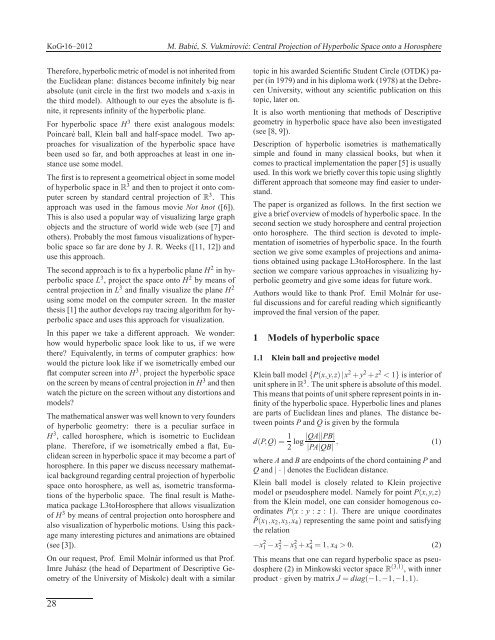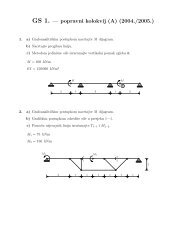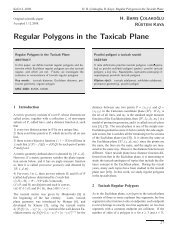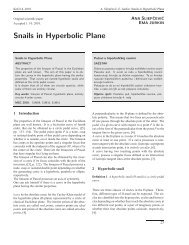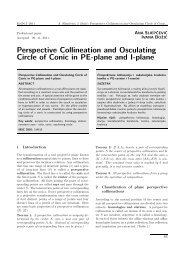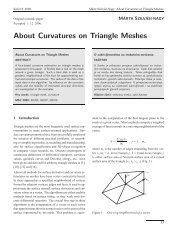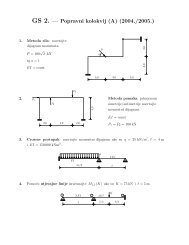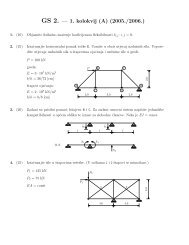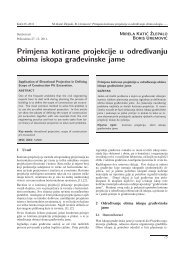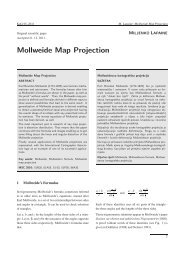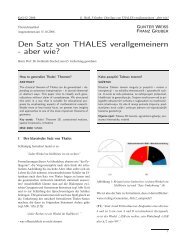pdf (4 MB), English, Pages 27
pdf (4 MB), English, Pages 27
pdf (4 MB), English, Pages 27
Create successful ePaper yourself
Turn your PDF publications into a flip-book with our unique Google optimized e-Paper software.
KoG • 16–2012<br />
M. Babić, S. Vukmirović: Central Projection of Hyperbolic Space onto a Horosphere<br />
Therefore, hyperbolic metric of model is not inherited from<br />
the Euclidean plane: distances become infinitely big near<br />
absolute (unit circle in the first two models and x-axis in<br />
the third model). Although to our eyes the absolute is finite,<br />
it represents infinity of the hyperbolic plane.<br />
For hyperbolic space H 3 there exist analogous models:<br />
Poincaré ball, Klein ball and half-space model. Two approaches<br />
for visualization of the hyperbolic space have<br />
been used so far, and both approaches at least in one instance<br />
use some model.<br />
The first is to represent a geometrical object in some model<br />
of hyperbolic space in R 3 and then to project it onto computer<br />
screen by standard central projection of R 3 . This<br />
approach was used in the famous movie Not knot ([6]).<br />
This is also used a popular way of visualizing large graph<br />
objects and the structure of world wide web (see [7] and<br />
others). Probably the most famous visualizations of hyperbolic<br />
space so far are done by J. R. Weeks ([11, 12]) and<br />
use this approach.<br />
The second approach is to fix a hyperbolic plane H 2 in hyperbolic<br />
space L 3 , project the space onto H 2 by means of<br />
central projection in L 3 and finally visualize the plane H 2<br />
using some model on the computer screen. In the master<br />
thesis [1] the author develops ray tracing algorithm for hyperbolic<br />
space and uses this approach for visualization.<br />
In this paper we take a different approach. We wonder:<br />
how would hyperbolic space look like to us, if we were<br />
there? Equivalently, in terms of computer graphics: how<br />
would the picture look like if we isometrically embed our<br />
flat computer screen into H 3 , project the hyperbolic space<br />
on the screen by means of central projection in H 3 and then<br />
watch the picture on the screen without any distortions and<br />
models?<br />
The mathematical answer was well known to very founders<br />
of hyperbolic geometry: there is a peculiar surface in<br />
H 3 , called horosphere, which is isometric to Euclidean<br />
plane. Therefore, if we isometrically embed a flat, Euclidean<br />
screen in hyperbolic space it may become a part of<br />
horosphere. In this paper we discuss necessary mathematical<br />
background regarding central projection of hyperbolic<br />
space onto horosphere, as well as, isometric transformations<br />
of the hyperbolic space. The final result is Mathematica<br />
package L3toHorosphere that allows visualization<br />
of H 3 by means of central projection onto horosphere and<br />
also visualization of hyperbolic motions. Using this package<br />
many interesting pictures and animations are obtained<br />
(see [3]).<br />
On our request, Prof. Emil Molnár informed us that Prof.<br />
Imre Juhász (the head of Department of Descriptive Geometry<br />
of the University of Miskolc) dealt with a similar<br />
topic in his awarded Scientific Student Circle (OTDK) paper<br />
(in 1979) and in his diploma work (1978) at the Debrecen<br />
University, without any scientific publication on this<br />
topic, later on.<br />
It is also worth mentioning that methods of Descriptive<br />
geometry in hyperbolic space have also been investigated<br />
(see [8, 9]).<br />
Description of hyperbolic isometries is mathematically<br />
simple and found in many classical books, but when it<br />
comes to practical implementation the paper [5] is usually<br />
used. In this work we briefly cover this topic using slightly<br />
different approach that someone may find easier to understand.<br />
The paper is organized as follows. In the first section we<br />
give a brief overview of models of hyperbolic space. In the<br />
second section we study horosphere and central projection<br />
onto horosphere. The third section is devoted to implementation<br />
of isometries of hyperbolic space. In the fourth<br />
section we give some examples of projections and animations<br />
obtained using package L3toHorosphere. In the last<br />
section we compare various approaches in visualizing hyperbolic<br />
geometry and give some ideas for future work.<br />
Authors would like to thank Prof. Emil Molnár for useful<br />
discussions and for careful reading which significantly<br />
improved the final version of the paper.<br />
1 Models of hyperbolic space<br />
1.1 Klein ball and projective model<br />
Klein ball model {P(x,y,z)|x 2 + y 2 + z 2 < 1} is interior of<br />
unit sphere in R 3 . The unit sphere is absolute of this model.<br />
This means that points of unit sphere represent points in infinity<br />
of the hyperbolic space. Hyperbolic lines and planes<br />
are parts of Euclidean lines and planes. The distance between<br />
points P and Q is given by the formula<br />
d(P,Q) = 1 |QA||PB|<br />
log<br />
2 |PA|QB| , (1)<br />
where A and B are endpoints of the chord containing P and<br />
Q and | · | denotes the Euclidean distance.<br />
Klein ball model is closely related to Klein projective<br />
model or pseudosphere model. Namely for point P(x,y,z)<br />
from the Klein model, one can consider homogenous coordinates<br />
P(x : y : z : 1). There are unique coordinates<br />
¯P(x 1 ,x 2 ,x 3 ,x 4 ) representing the same point and satisfying<br />
the relation<br />
−x 2 1 − x 2 2 − x 2 3 + x 2 4 = 1, x 4 > 0. (2)<br />
This means that one can regard hyperbolic space as pseudosphere<br />
(2) in Minkowski vector space R (3,1) , with inner<br />
product · given by matrix J = diag(−1,−1,−1,1).<br />
28


